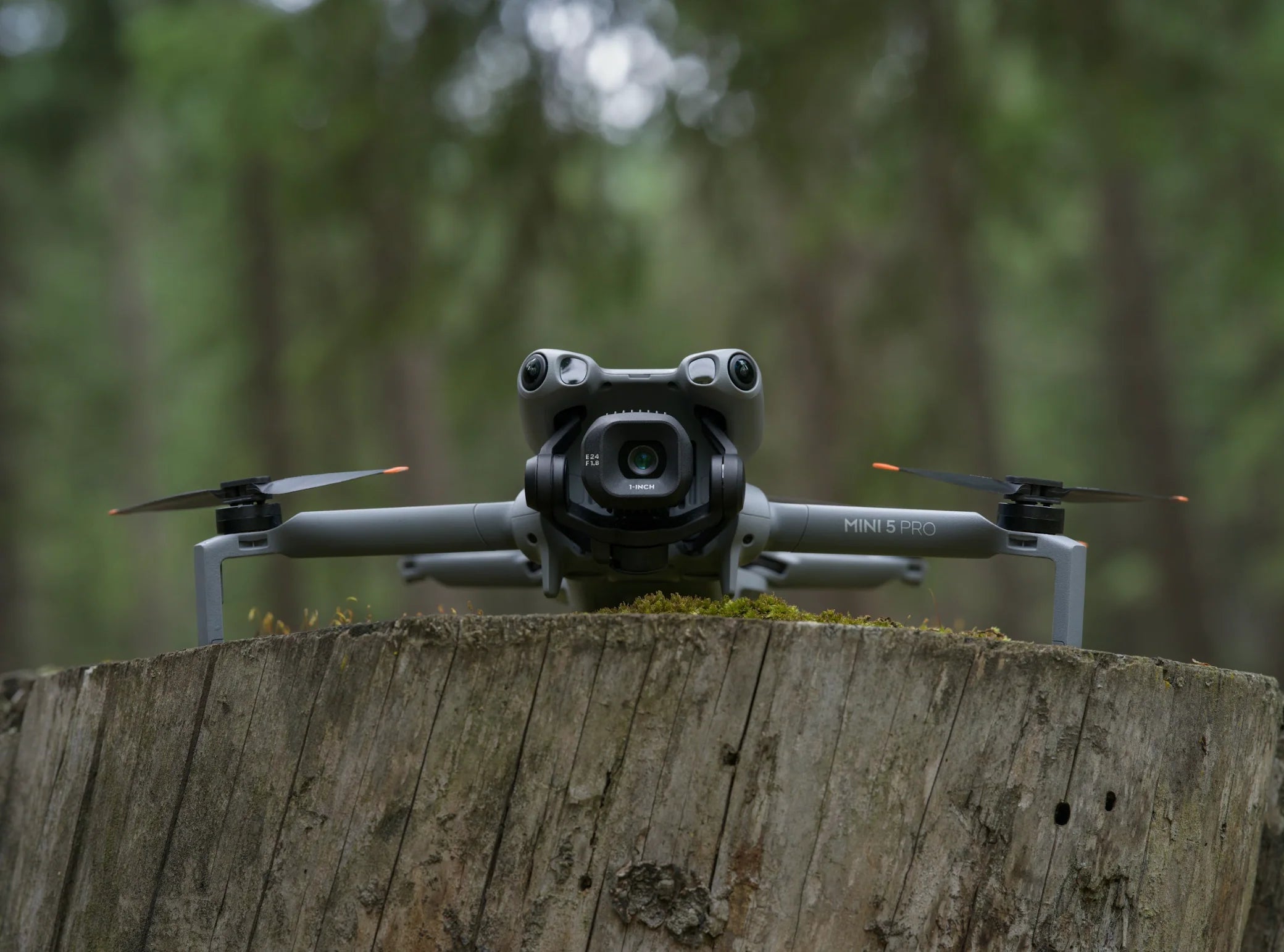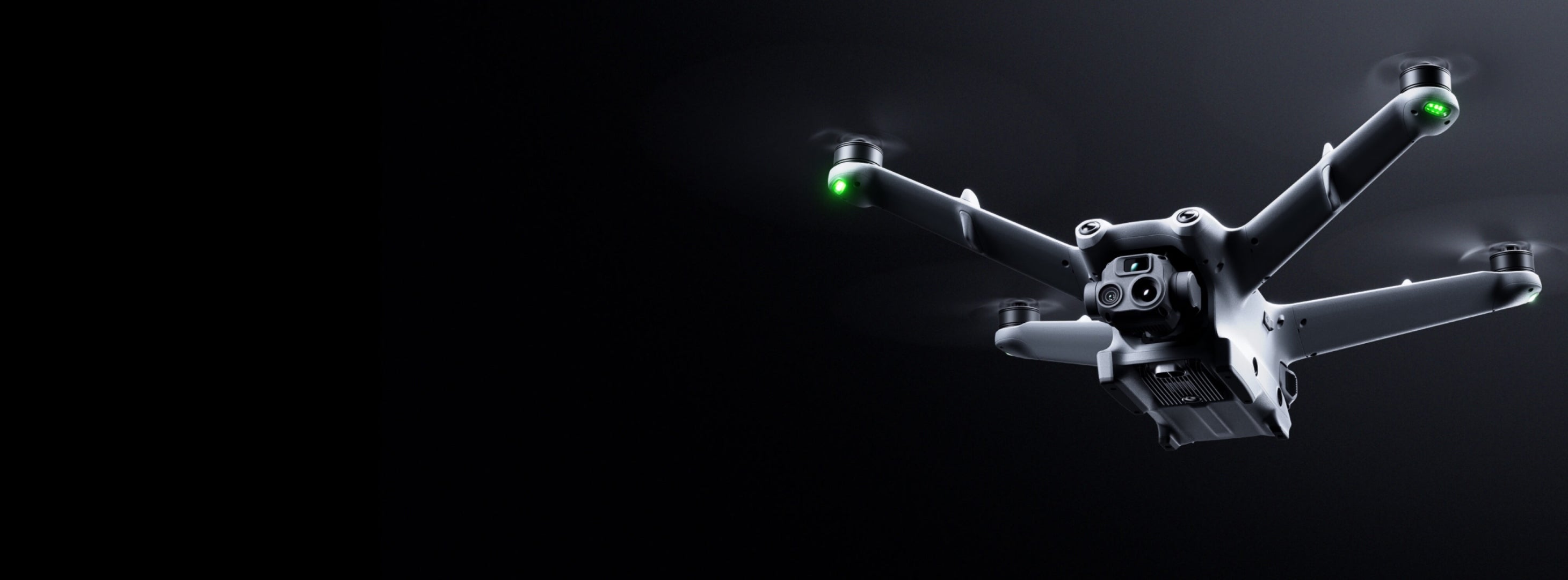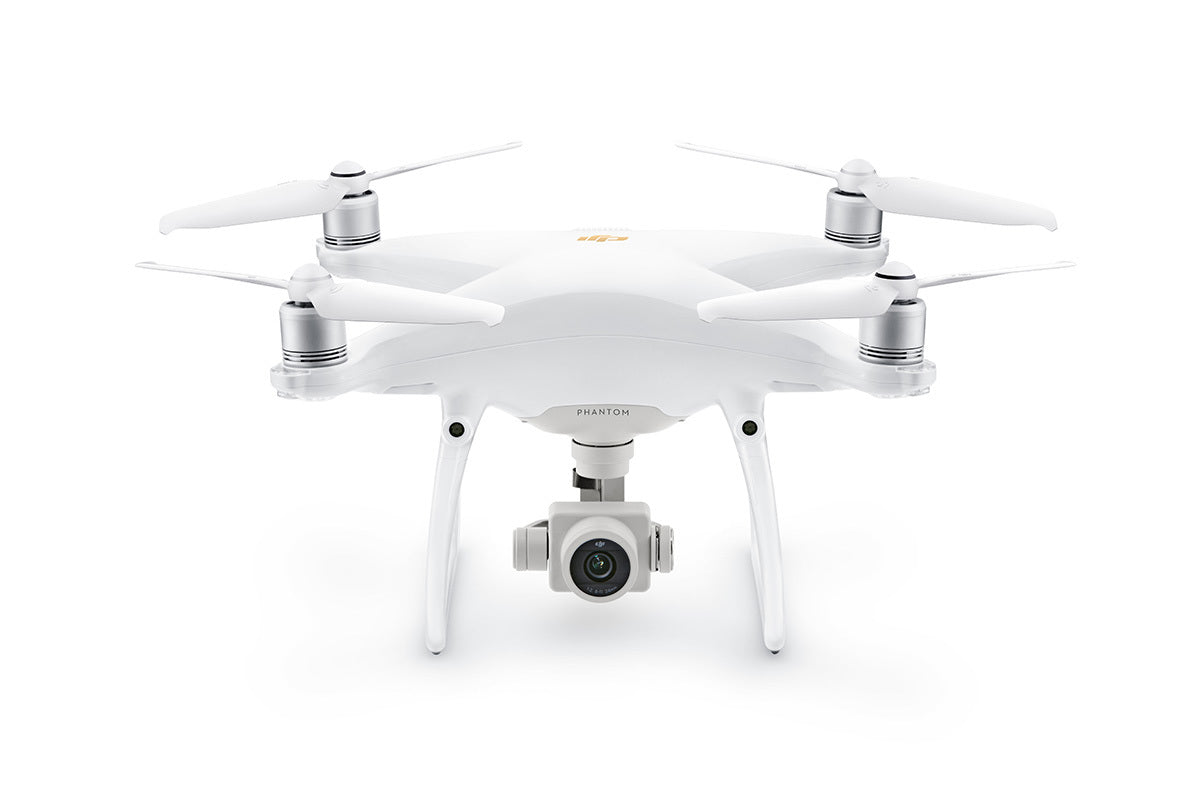
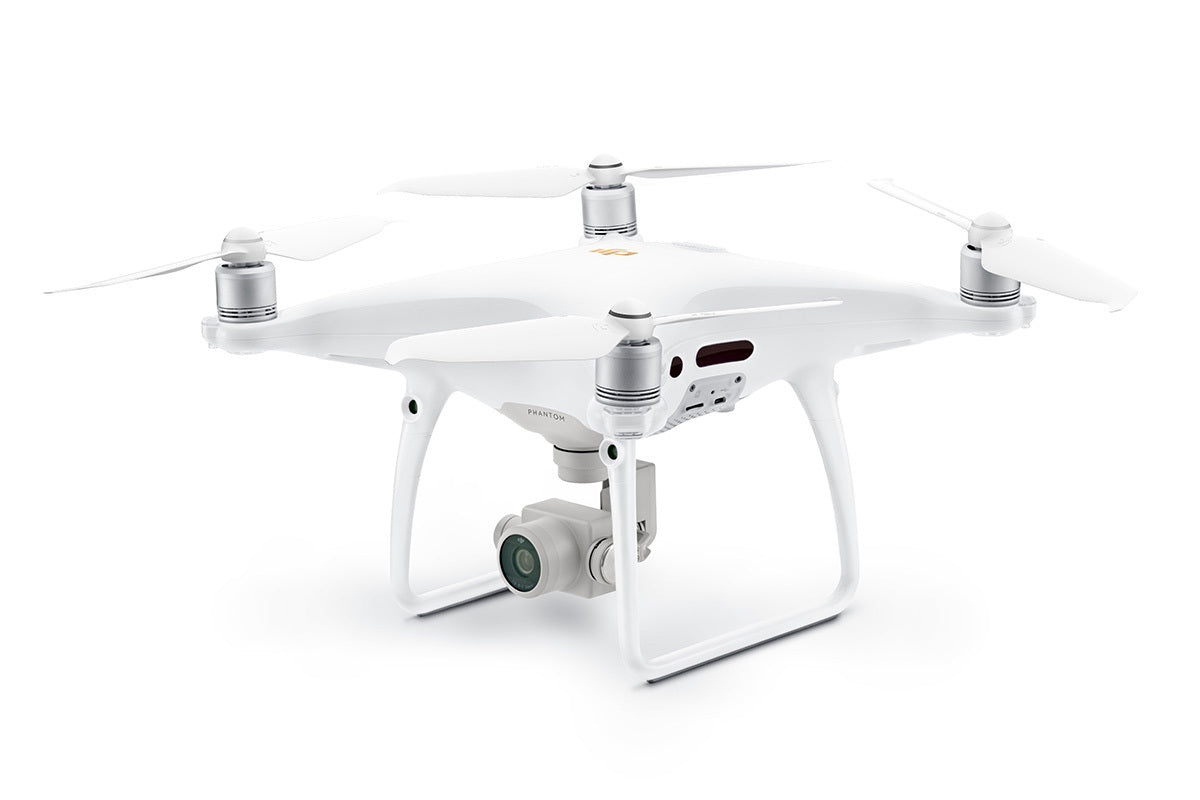
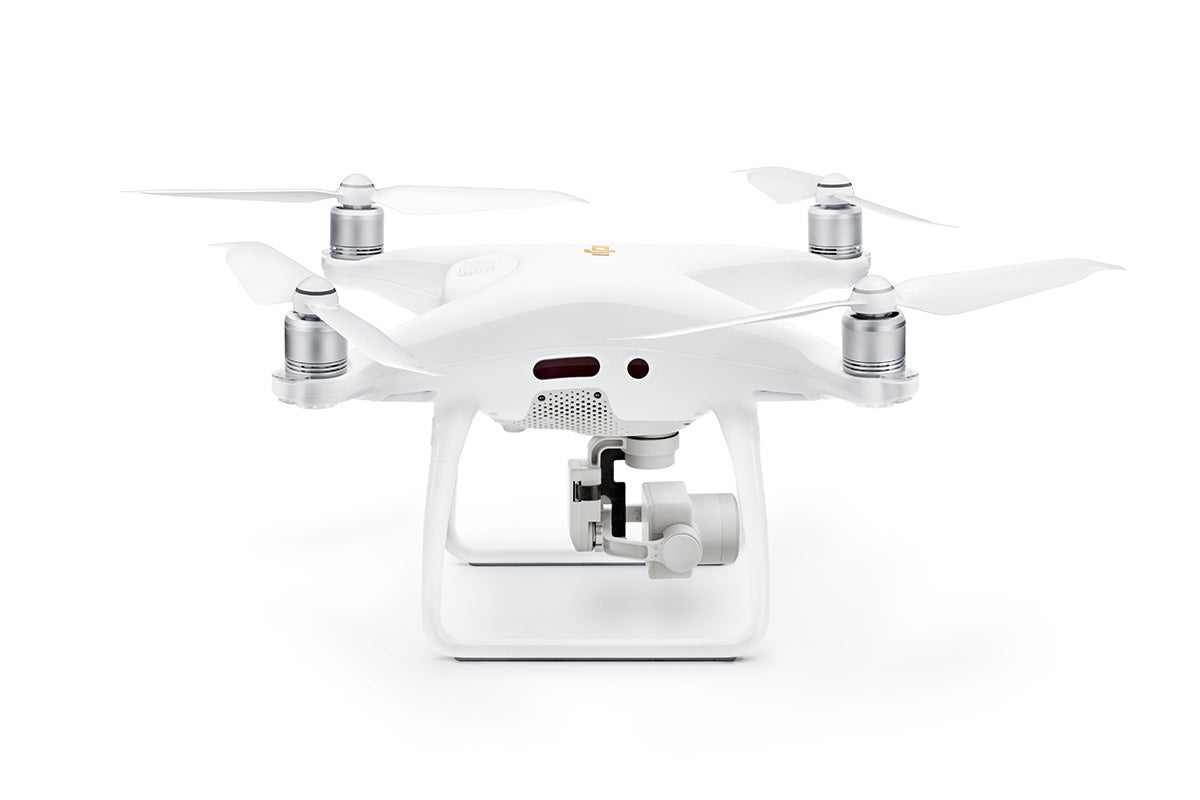
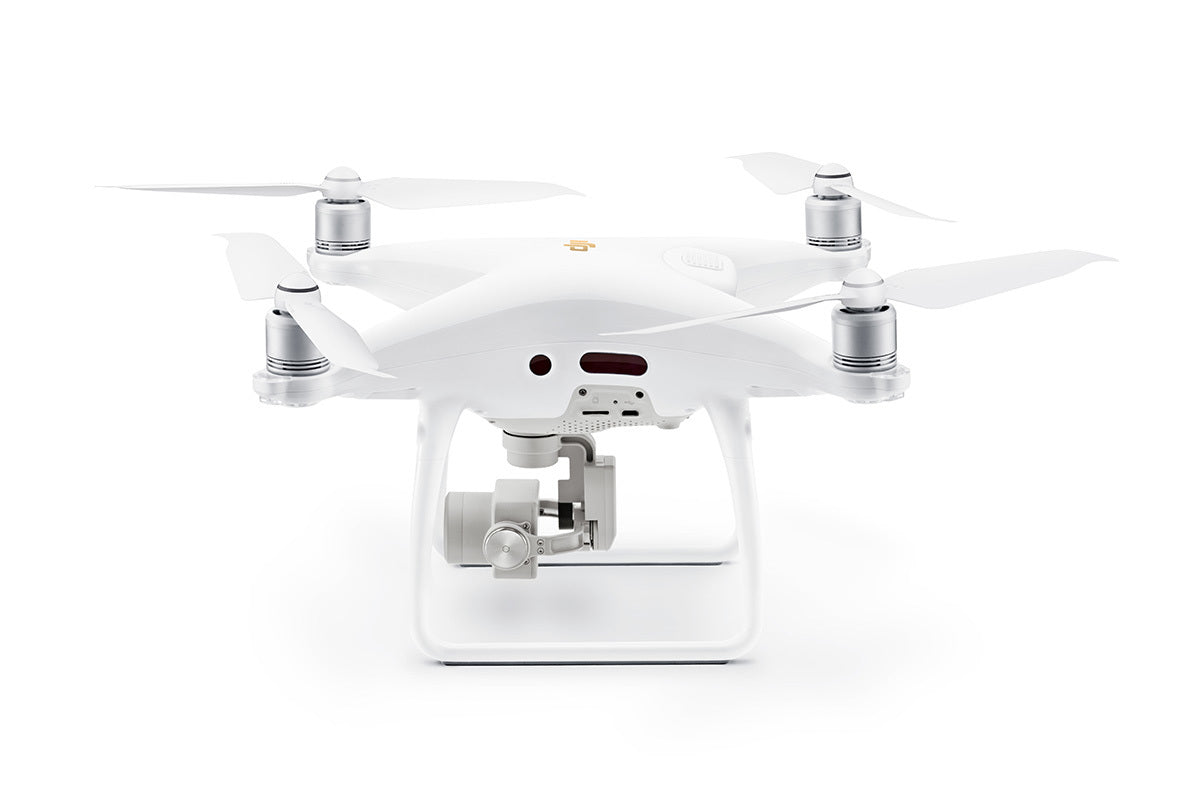
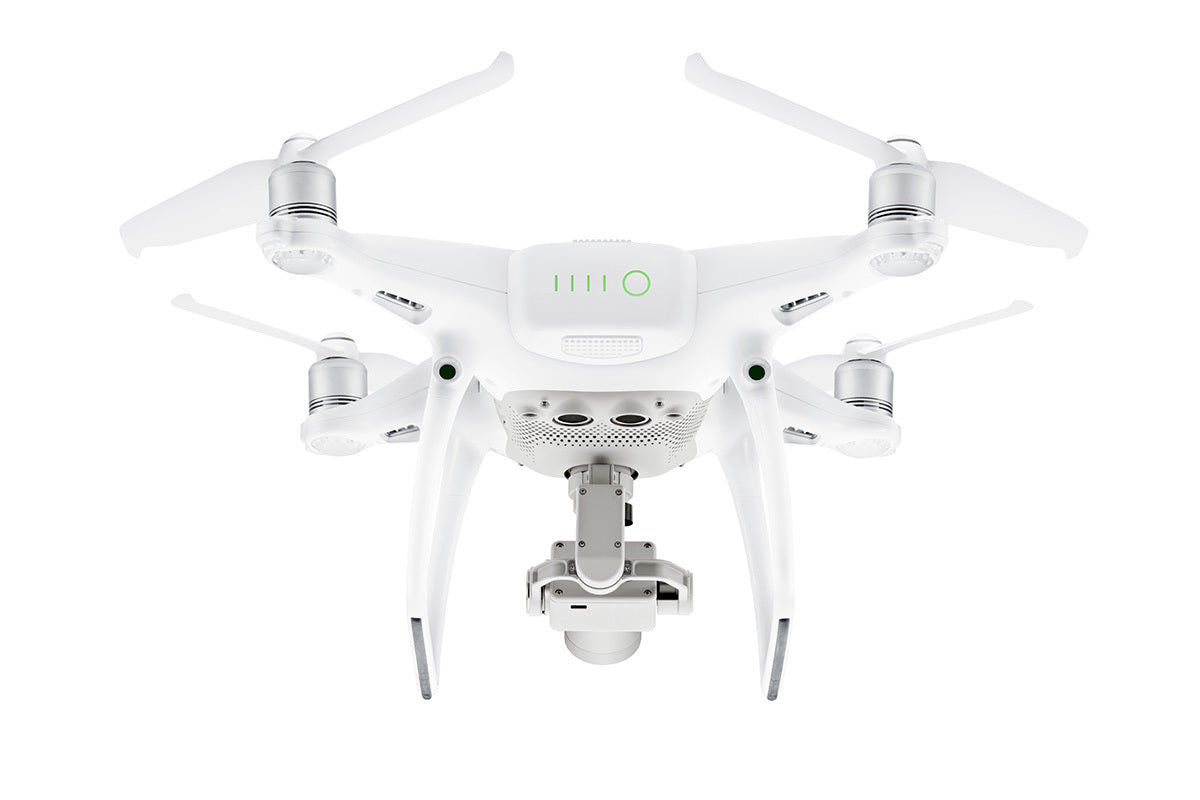
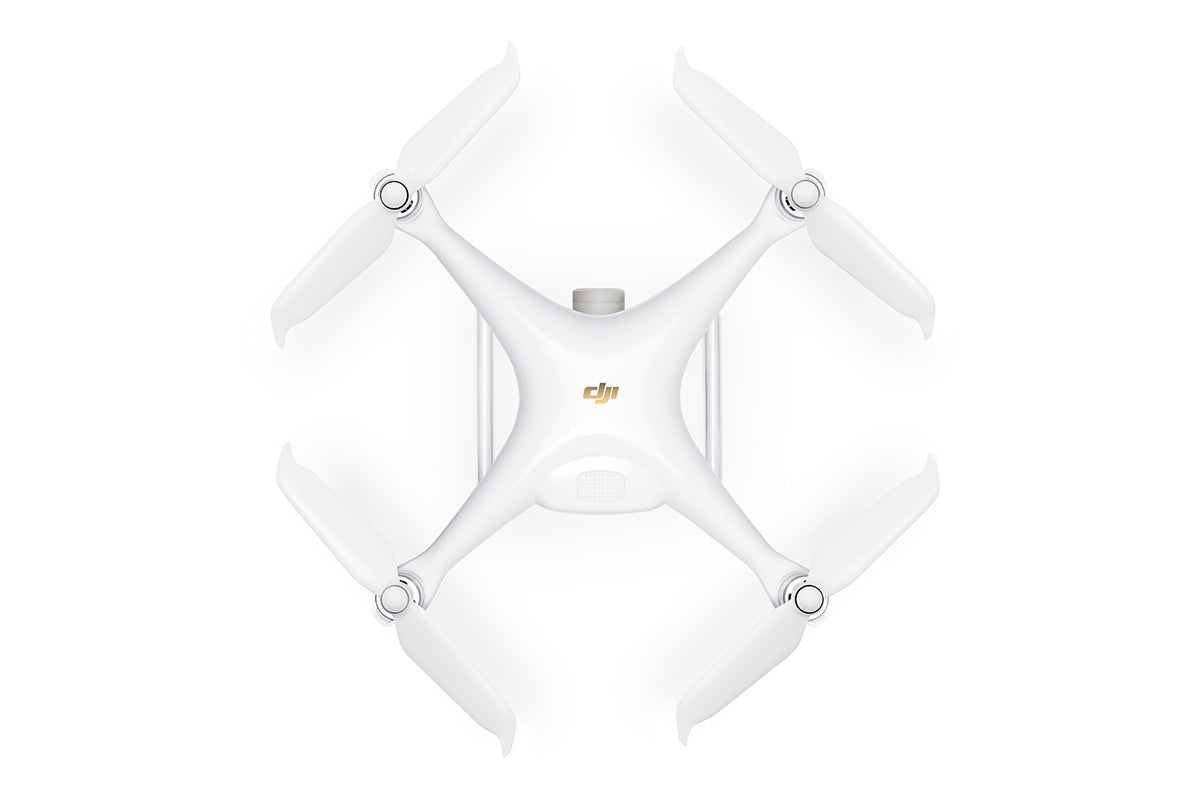

DJI
Phantom 4 Pro V2.0
Choose options
Overview

The new Phantom 4 Pro V2.0 features an OcuSync HD transmission system, which supports automatic dual-frequency band switching and connects to DJI Goggles wirelessly. Like the Phantom 4 Pro and Advanced, the Phantom 4 Pro V2.0 is equipped with a 1-inch 20-megapixel sensor capable of shooting 4K/60fps video and Burst Mode stills at 14 fps. Plus, its FlightAutonomy system includes dual rear vision sensors and infrared sensing systems for a total of 5 directions of obstacle sensing and 4 directions of obstacle avoidance.

Quieter, More enjoyable flights
New aerodynamic 9455S propellers and new FOC ESC drivers offer improved noise control and sinusoidal current for increased stability. Aircraft noise has been reduced by up to 4dB* (60%) for quieter, more enjoyable flights.


New OcuSync Video Transmission
The Phantom 4 Pro V2.0’s remote controller uses OcuSync video transmission,* which employs time-division multiplexing technology to send control signal and receive video signal simultaneously. When the controller is powered on, the OcuSync system scans for the frequency band with lowest interference and switches accordingly to maintain clear transmission. Also, thanks to OcuSync, the Phantom 4 Pro V2.0 wirelessly connects to DJI Goggles. Free from cable constraints, you can enjoy exciting FPV flight at speeds of up to 72kph (45mph) in S-mode.

Dual-Frequency Transmission
The Phantom 4 Pro V2.0 remote controller utilizes the OcuSync HD video transmission system that operates on both 2.4GHz and 5.8GHz frequency bands, with a max transmission range of 7 km. Assessing environmental conditions, the aircraft chooses the best band in which to operate, helping to reduce signal interference.

Fast Switching of Frequency Point
OcuSync video transmission technology can sense environmental interference in real time. When the interference is strong, the system switches to the frequency point with the least amount of intrusion.

1080p Live View
With bi-directional perception and error-resilient technology, the Phantom 4 Pro V2.0 saves up to 30% of its bandwidth and solves common problems such as video lag and even compression artifacts within video transmission, providing crystal-clear live video at up to 1080p.

Multiple Device Connectivity
OcuSync can connect to multiple devices at the same time. It can link two remote controllers* or a remote controller and set of DJI Goggles. OcuSync can sense aircraft altitude and the relative position of aircrafts while choosing the ideal antenna combination for Goggles, the remote controller, and aircraft for optimal signal transmission.* Linking of two remote controllers will be available in a future firmware update.

See A Different World
The Phantom 4 Pro V2.0 wirelessly connects to DJI Goggles, putting you directly in the heart of the action with dual LTPS displays that offer a high-quality 1080p live camera view with an 85° FOV. Connected via OcuSync, users can experience fast and clear FPV flight with incredibly low latency.Plus, controlling your Phantom with DJI Goggles is more intuitive than ever. Just enable Head Tracking, which allows you to move the aircraft or gimbal simply by turning your head.
Tech Specs
|
Aircraft |
|
| Weight (Battery & Propellers Included) | 1375 g |
| Diagonal Size (Propellers Excluded) | 350 mm |
| Max Ascent Speed | S-mode: 6 m/s |
| P-mode: 5 m/s | |
| Max Descent Speed | S-mode: 4 m/s |
| P-mode: 3 m/s | |
| Max Speed | S-mode: 45 mph (72 kph) |
| A-mode: 36 mph (58 kph) | |
| P-mode: 31 mph (50 kph) | |
| Max Tilt Angle | S-mode: 42° |
| A-mode: 35° | |
| P-mode: 25° | |
| Max Angular Speed | S-mode: 250°/s |
| A-mode: 150°/s | |
| Max Service Ceiling Above Sea Level | 19685 feet (6000 m) |
| Max Wind Speed Resistance | 10 m/s |
| Max Flight Time | Approx. 30 minutes |
| Operating Temperature Range | 32° to 104°F (0° to 40°C) |
| Satellite Positioning Systems | GPS/GLONASS |
| Hover Accuracy Range | Vertical: |
| ±0.1 m (with Vision Positioning) | |
| ±0.5 m (with GPS Positioning) | |
| Horizontal: | |
| ±0.3 m (with Vision Positioning) | |
| ±1.5 m (with GPS Positioning) | |
| Gimbal | |
| Stabilization | 3-axis (pitch, roll, yaw) |
| Controllable Range | Pitch: -90° to +30° |
| Max Controllable Angular Speed | Pitch: 90°/s |
| Angular Vibration Range | ±0.02° |
| Infrared Sensing System | |
| Obstacle Sensory Range | 0.6 - 23 feet (0.2 - 7 m) |
| FOV | 70° (Horizontal), ±10° (Vertical) |
| Measuring Frequency | 10 Hz |
| Operating Environment | Surface with diffuse reflection material, and reflectivity > 8% (such as wall, trees, humans, etc.) |
| Remote Controller | |
| Operating Frequency | 2.400 - 2.483 GHz and 5.725 - 5.850 GHz |
| Max Transmission Distance | 2.400 - 2.483 GHz (Unobstructed, free of interference) |
| FCC: 4.3 mi (7 km) | |
| CE: 2.5 mi (4 km) | |
| SRRC: 2.5 mi (4 km) | |
| 5.725 - 5.850 GHz (Unobstructed, free of interference) | |
| FCC: 4.3 mi (7 km) | |
| CE: 1.2 mi (2 km) | |
| SRRC: 3.1 mi (5 km) | |
| Operating Temperature Range | 32° to 104°F (0° to 40°C) |
| Battery | 6000 mAh LiPo 2S |
| Transmitter Power (EIRP) | 2.400 - 2.483 GHz |
| FCC: 26 dBm | |
| CE: 20 dBm | |
| SRRC: 20 dBm | |
| MIC: 17 dBm | |
| 5.725 - 5.850 GHz | |
| FCC: 26 dBm | |
| CE: 14 dBm | |
| SRRC: 20 dBm | |
| MIC: - | |
| Operating Current/Voltage | 1.2 A@7.4 V |
| Video Output Port | GL300K: HDMI |
| GL300L: USB | |
| Mobile Device Holder | GL300K: Built-in display device (5.5 inch screen, 1920×1080, 1000 cd/m2, Android system, 4 GB RAM+16 GB ROM) |
| GL300L: Tablets and smart phones | |
| Vision System | |
| Vision System | Forward Vision System |
| Backward Vision System | |
| Downward Vision System | |
| Velocity Range | ≤31 mph (50 kph) at 6.6 ft (2 m) above ground |
| Altitude Range | 0 - 33 feet (0 - 10 m) |
| Operating Range | 0 - 33 feet (0 - 10 m) |
| Obstacle Sensory Range | 2 - 98 feet (0.7 - 30 m) |
| FOV | Forward: 60°(Horizontal), ±27°(Vertical) |
| Backward: 60°(Horizontal), ±27°(Vertical) | |
| Downward: 70°(Front and Rear), 50°(Left and Right) | |
| Measuring Frequency | Forward: 10 Hz |
| Backward: 10 Hz | |
| Downward: 20 Hz | |
| Operating Environment | Surface with clear pattern and adequate lighting (lux>15) |
| Camera | |
| Sensor | 1’’ CMOS |
| Effective pixels: 20M | |
| Lens | FOV 84° 8.8 mm/24 mm (35 mm format equivalent) f/2.8 - f/11 auto focus at 1 m - ∞ |
| ISO Range | Video: |
| 100 - 3200 (Auto) | |
| 100 - 6400 (Manual) | |
| Photo: | |
| 100 - 3200 (Auto) | |
| 100- 12800 (Manual) | |
| Mechanical Shutter Speed | 8 - 1/2000 s |
| Electronic Shutter Speed | 8 - 1/8000 s |
| Image Size | 3:2 Aspect Ratio: 5472 × 3648 |
| 4:3 Aspect Ratio: 4864 × 3648 | |
| 16:9 Aspect Ratio: 5472 × 3078 | |
| PIV Image Size | 4096×2160(4096×2160 24/25/30/48/50p) |
| 3840×2160(3840×2160 24/25/30/48/50/60p) | |
| 2720×1530(2720×1530 24/25/30/48/50/60p) | |
| 1920×1080(1920×1080 24/25/30/48/50/60/120p) | |
| 1280×720(1280×720 24/25/30/48/50/60/120p) | |
| Still Photography Modes | Single Shot |
| Burst Shooting: 3/5/7/10/14 frames | |
| Auto Exposure Bracketing (AEB): 3/5 bracketed frames at 0.7 EV Bias | |
| Interval: 2/3/5/7/10/15/20/30/60 s | |
| Video Recording Modes | H.265 |
| C4K:4096×2160 24/25/30p @100Mbps | |
| 4K:3840×2160 24/25/30p @100Mbps | |
| 2.7K:2720×1530 24/25/30p @65Mbps | |
| 2.7K:2720×1530 48/50/60p @80Mbps | |
| FHD:1920×1080 24/25/30p @50Mbps | |
| FHD:1920×1080 48/50/60p @65Mbps | |
| FHD:1920×1080 120p @100Mbps | |
| HD:1280×720 24/25/30p @25Mbps | |
| HD:1280×720 48/50/60p @35Mbps | |
| HD:1280×720 120p @60Mbps | |
| H.264 | |
| C4K:4096×2160 24/25/30/48/50/60p @100Mbps | |
| 4K:3840×2160 24/25/30/48/50/60p @100Mbps | |
| 2.7K:2720×1530 24/25/30p @80Mbps | |
| 2.7K:2720×1530 48/50/60p @100Mbps | |
| FHD:1920×1080 24/25/30p @60Mbps | |
| FHD:1920×1080 48/50/60 @80Mbps | |
| FHD:1920×1080 120p @100Mbps | |
| HD:1280×720 24/25/30p @30Mbps | |
| HD:1280×720 48/50/60p @45Mbps | |
| HD:1280×720 120p @80Mbps | |
| Max Video Bitrate | 100 Mbps |
| Supported File Systems | FAT32 (≤32 GB); exFAT (>32 GB) |
| Photo | JPEG, DNG (RAW), JPEG + DNG |
| Video | MP4/MOV (AVC/H.264; HEVC/H.265) |
| Supported SD Cards | Micro SD |
| Max Capacity: 128GB | |
| Write speed ≥15MB/s, Class 10 or UHS-1 rating required | |
| Operating Temperature Range | 32° to 104°F (0° to 40°C) |
| Intelligent Flight Battery | |
| Capacity | 5870 mAh |
| Voltage | 15.2 V |
| Battery Type | LiPo 4S |
| Energy | 89.2 Wh |
| Net Weight | 468 g |
| Charging Temperature Range | 41° to 104°F (5° to 40°C) |
| Max Charging Power | 160 W |
| App / Live View | |
| Mobile App | DJI GO 4 |
| Live View Working Frequency | 2.4 GHz ISM, 5.8 GHz ISM |
| Live View Quality | 720P @ 30fps, 1080P @ 30fps |
| Latency | Phantom 4 Pro V2.0: 220 ms (depending on conditions and mobile device) |
| Phantom 4 Pro + V2.0:160 - 180 ms | |
| Required Operating Systems | iOS 9.0 or later |
| Android 4.4.0 or later |
In the Box

F.A.Q.
PRODUCT
1.What are the main similarities and differences between the Phantom 4 Pro V2.0 and Phantom 4 Pro?
The Phantom 4 Pro V2.0 uses the same camera as the Phantom 4 Pro and is equipped with a 1-inch 20-megapixel sensor capable of shooting 4K/60fps video at 100Mbps. Also, like the Phantom 4 Pro, V2.0 features a 30-minute maximum flight time and 7-kilometer long-range control. The remote controller of the Phantom 4 Pro V2.0 also supports 2.4 and 5.8GHz frequency switching, and a remote controller a with built-in screen is also available. Different from the Phantom 4 Pro, the Phantom 4 Pro V2.0 is equipped with an OcuSync transmission system, which allows the drone to connect to DJI Goggles wirelessly. The Phantom 4 Pro V2.0 also features an upgraded propulsion system with FOC sinusoidal driver ESCs and 9455S quick-release propellers that reduce noise and make the drone more aerodynamic. *The remote controller of Phantom 4 Pro V2.0 is not compatible with the Phantom 4 Pro, which uses Lightbridge transmission. Other accessories such as batteries, chargers, and ND filters are compatible with both the Phantom 4 Pro and Phantom 4 Pro V2.0.
2.What, if any, are the main differences between the Phantom 4 Pro V2.0 and Phantom 4 Pro Obsidian?
The Phantom 4 Pro Obsidian comes in a matte black casing. Functionally, the Phantom 4 Pro Obsidian is the same as the Phantom 4 Pro. As such, the main differences between the Phantom 4 Pro Obsidian and Phantom 4 Pro V2.0 are mentioned in question 1.
3.Which Micro SD cards are supported?
Currently supported Micro SD cards are:
Sandisk Extreme 32GB UHS-3 V30 MicroSDHC
Sandisk Extreme 64GB UHS-3 V30 MicroSDXC
Panasonic 32GB UHS-3 MicroSDHC
Panasonic 64GB UHS-3 MicroSDXC
Samsung PRO 32GB UHS-1 MicroSDHC
Samsung PRO 64GB UHS-3 MicroSDXC
Samsung PRO 128GB UHS-3 MicroSDXC
*It's not recommend to use the Patriot EPPRO 64GB MicroSDXC UHS-3.
4.Will the Phantom 4 Pro V2.0 have an Obsidian version in the future?
No.
CAMERA
1.What are some key features of the Phantom 4 Pro V2.0’s camera?
The Phantom 4 Pro V2.0 camera is still equipped with a 1-inch 20-megapixel sensor and has a manually adjustable aperture from F2.8 to F11. It also supports autofocus by half-pressing the Shutter button and has a focus range from 1m to infinity. Always refocus before capturing additional shots if the subject has moved beyond the focus point. Focus at infinity if the subject is over 98ft (30m) away. Refocusing is also needed when switching from close shots to long shots during recording.
2.What advantages does the Phantom 4 Pro V2.0 have for shooting video?
The Phantom 4 Pro V2.0 can record UHD 4K (4096×2160) at 60fps, at a maximum bitrate of 100Mbps using the H.264 codec and also supports H.265. It also allows you to capture still images while filming.
3.What is the resolution and format of photos captured while recording video?
Photos will be captured as JPEG in the same resolution as the video recording.
4.What is the advantage using the new H.265 video format?
H.265 retains 50% more information than H.264, creating more detailed and vivid images.
5.What’s the benefit of having a mechanical shutter?
An electronic shutter may cause artifacts and distortion, such as jello, when shooting fast moving objects. A mechanical shutter prevents this and guarantees a high-quality image.
6.Does the Phantom 4 Pro V2.0 support focus adjustment?
Yes. Tap a point on the display to focus at that point after switching from Metering to Focus mode. Autofocus can also be triggered by half-pressing the Shutter button before fully pressing the button to capture an image. Focus can be set between 1m and infinity.
7.What are the main features of the Phantom 4 Pro V2.0 camera lens?
The Phantom 4 Pro V2.0 uses a camera lens optimized for aerial imaging, with an aperture range from F2.8 to F11 and a 24mm equivalent focal length. It’s equipped with a mechanical shutter and adjustable aperture range, with autofocus support.
OBSTACLE SENSING SYSTEM
1.When does the infrared sensing system work during flight?
Only in Beginner mode and Tripod mode.
2.How does the infrared sensing system work?
Available in Beginner Mode and Tripod Mode only, the infrared sensing system has a sensing field with a 70° angle horizontally and 20° angle vertically. The radiated infrared light is reflected back by obstacles, allowing the sensors to “see” them at a distance of up to 23ft (7m) by calculating the difference in projection and reflection times and using this information to create a 3D model of the environment and obstacles in it.
3.How does the Phantom 4 Pro V2.0’s obstacle sensing system work?
The Phantom 4 Pro V2.0 uses the same obstacle sensing system as the Phantom 4 Pro. Phantom 4 Pro V2.0’s maximum forward obstacle sensing range has been extended to 98ft (30m), with the rear sensing system sharing the same capability. Additionally, the Phantom 4 Pro V2.0 is equipped with infrared sensors on both sides of the aircraft, precisely detecting the distance between the aircraft and obstacles within a range of up to 23ft (7m).
4.Is there any difference between the front and rear obstacle sensing systems?
No.
REMOTE CONTROLLER
1.Is the remote controller of Phantom 4 Pro V2.0 compatible with that of Phantom 4 Pro?
No. The remote controller of Phantom 4 Pro V2.0 cannot be used with other Phantom series drones.
2.What’s new about the Phantom 4 Pro V2.0 remote controller?
The Phantom 4 Pro V2.0 remote controller is equipped with an OcuSync transmission system and can be connected to DJI Goggles wirelessly for immersive FPV flight at up to 72 kph in S-mode.
The Phantom 4 Pro V2.0 is compatible with two remote controller types: the standard version and the built-in screen version. Both can switch between 2.4GHz and 5.8GHz frequency bands with a maximum controllable range of 4.3mi (7km) (unobstructed, free of interference, FCC compliant), and both can focus by half-pressing the shutter release button.
The Phantom 4 Pro+ controller has a 5.5-inch 1080p display, with 1000 cd/m2 brightness and built-in DJI GO 4 app. Its remote controller is also equipped with an HDMI port, Micro SD slot, microphone, loudspeaker, and Wi-Fi connectivity.
3.Can I detach the integrated display from the Phantom 4 Pro+ V2.0 remote controller?
No.
4. Can I connect an iOS device or Android device to the Phantom 4 Pro+ V2.0 remote controller to use DJI GO 4?
No.
5.Does the Phantom 4 Pro + V2.0 remote controller have a built-in loudspeaker and microphone?
Yes.
6.What is the resolution of the Phantom 4 Pro +V2.0 remote controller display?
1920*1080
7.What apps are preloaded on the Phantom 4 Pro + V2.0 screen remote controller display?
Popular social media apps and DJI GO 4.
8.What operating system does the Phantom 4 Pro +V2.0 remote controller display use?
It uses a customized DJI system.
9. Is the remote controller’s screen display’s brightness adjusted automatically or manually?
Both.
10.Can I download other apps onto the Phantom 4 Pro + V2.0 remote controller display?
Users can install third-party apps when the Phantom 4 Pro+ V2.0 remote controller is updated to the latest firmware version.
11.Does the Phantom 4 Pro + V2.0 remote controller support Wi-Fi and Bluetooth connectivity?
It supports Wi-Fi but not Bluetooth.
INTELLIGENT FUNCTIONS
1.What Intelligent Flight Modes are on the Phantom 4 Pro V2.0?
The Phantom 4 Pro V2.0 features Intelligent Flight Modes such as TapFly, ActiveTrack, Draw, Gesture, Tripod, and more.
2.How has the Phantom 4 Pro V2.0’s Return to Home function been improved?
The Phantom 4 Pro V2.0’s Return to Home function forms a map of its environment in real time. The aircraft will choose the best flight path to return home and senses as far as 300m away to avoid obstacles more effectively. If the control signal is lost, the Phantom 4 Pro V2.0 will retrace its original path to regain its connection after one minute. When it reconnects, it will return to home following a straight route. If it fails to regain connection, it will also revert to straight line RTH.
3.How do I use Narrow Sensing?
First, set C1 or C2 to activate Narrow Sensing. When flying in a narrow space, activate Narrow Sensing, and the aircraft will adjust its sensing range and flight speed to fly safely through narrows gaps.
PROPULSION SYSTEM
1.Can use I Phantom 4 Pro propellers on the Phantom 4 Pro V2.0?
Yes. Phantom 4 Pro V2.0 and Phantom 4 Pro propellers are cross-compatible. However, Phantom 4 Pro propellers (9450S) are less aerodynamic and louder than Phantom 4 Pro V2.0 propellers (9455S propellers).
2. How has the Phantom 4 Pro V2.0’s propulsion system been optimized?
New FOC sinusoidal driver ESCs not only reduce electromagnetic noise, but also improve the overall efficiency of the ESCs. Also, new 9455S quick-release propellers make the Phantom 4 Pro V2.0 more aerodynamic and reduce noise. It has the same maximum flight time and maximum speed as the Phantom 4 Pro.
VIDEO TRANSMISSION SYSTEM
1.What is the difference between the Phantom 4 Pro V2.0 and Phantom 4 Pro’s video transmission system?
The Phantom 4 Pro V2.0 uses an OcuSync video transmission system and time division multiplexer that supports uploading remote control signal and receiving video transmission signal in the same frequency band. The Phantom 4 Pro uses a Lightbridge video transmission system.
Both drones have a transmission distance of up to 4.3 mi (7km), and users can switch between 2.4 and 5.8GHz control frequencies to improve signal stability and cut through interference.
BATTERIES and BATTERY CHARGER
1.Are the Phantom 4 Pro V2.0 batteries and battery charger compatible with the Phantom 4?
Yes.
2.What is the capacity of the Phantom 4 Pro V2.0 battery? How much has the flight time been extended compared to the Phantom 4?
The battery capacity is 5870mAh. It flies for two additional minutes compared to the Phantom 4.
FIRMWARE UPGRADE
1.During updating, if the battery level of the aircraft battery or controller battery drops below 50%, will the update process fail?
Yes. Always use a battery with more than 50% power when upgrading.
2.What if battery firmware is not consistent with the updated aircraft?
Use DJI GO 4 to update the battery firmware to the appropriate version.
3.What is the difference between updating the firmware on the Phantom 4 Pro V2.0 and Phantom 4 Pro?
When updating firmware with the DJI GO 4 app for Phantom 4 Pro V2.0, confirm that the remote controller and aircraft are connected. Then download the firmware for the update following the prompts in the app. No OTG cable is required, unlike with the Phantom 4 Pro. Please refer to the instructions below when using DJI Assistant 2 to update. 1. To update the remote controller only: Power off the aircraft and connect the remote controller to your computer via USB. 2. To update the aircraft only: Connect the aircraft to your computer via USB. 3. To update the aircraft and remote controller together: Power on the aircraft and link it to the remote controller then connect the remote controller to the computer via USB; Once the aircraft and remote controller are connected to your computer, DJI Assistant 2 will respond to the device that was connected first.
